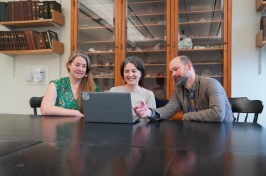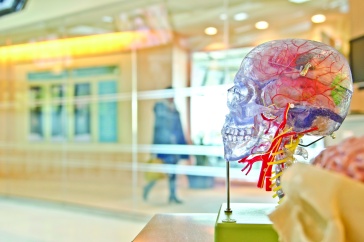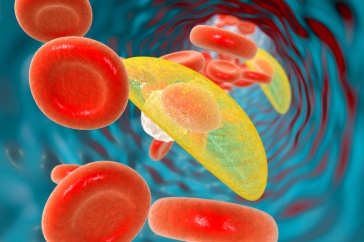
The Center of Integrated Biomedical and Bioengineering Research (CIBBR) is hosting a series of seminars in 2018-2019 that will bring prominent scientists from the fields of biomedical and bioengineering research to UNH's campus to present and meet with faculty.
The first in this series will be Brian T. Cunningham , a distiguished professor from the University of Illinois at Urbana-Champaign whose reasearch specializes in Nanosensor Technology.
Topic: New Forms Of Microscopy Enabled By Nanostructured Surfaces
When & Where: Oct. 24, 2018 12:10 - 1 p.m. Kingsbury Hall N101
Abstract: Since the advent of optical microscopy, a flat glass microscope slide has been the standard surface upon which tissues, cells, and biomolecules are attached for observation. Recently, we have utilized the optically resonant properties of nanostructured photonic crystal (PC) surfaces to enable several new microscopy modalities where the nanostructure provides new forms of contrast for a wide variety of compelling applications. By designing PC surfaces with resonances that match the excitation and emission spectra of photon emitters such as fluorophores and quantum dots, PC enhanced fluorescence (PCEF) microscopy reduces the detection limits of any surface-based fluorescence assay. By generating spatial images of the PC resonant reflection intensity, we can selectively and dynamically visualize the cell-extracellular matrix interface during processes that include stem cell differentiation, cancer cell response to drugs, and chemotaxis – including the ability to observe the formation and evolution of cell membrane focal adhesion sites. We call this approach Photonic Resonator Outcoupler Microscopy (PROM), as we observe highly localized outcoupling of light from the PC that occurs due to scattering by dense regions in the cell membrane. Further, by utilizing metallic nanoparticle tags with plasmon resonances that match the PC resonance, we obtain highly efficient coupling of light into nanometer-scale electromagnetic hotspots, that is accompanied by highly localized “quenching” of the PC reflection efficiency, which we are using for digital-resolution detection of miRNA biomarkers for cancer with 100 aM limits of detection, using an approach called Photonic Resonator Absorption Microscopy (PRAM). The seminar will describe the physical principles, nanostructure design/fabrication, instrumentation, and applications for nanostructure-enabled microscopy for disease diagnostics, personalized medicine, and life science research.
Brian Cunningham Bio: Professor Cunningham completed his Ph.D. at the University of Illinois at Urbana-Champaign in May 1990. He joined the Research Division of Raytheon, in Lexington, Massachusetts, from 1991-1995, where he was the group leader for Infrared Sensors Fabrication. He joined the Micromachined Sensors Group at the Charles Stark Draper Laboratory in Cambridge, Massachusetts, in 1995 as a senior member of the technical staff, where he later served in management roles that included Group Leader for MEMS Sensors, and Technical Director for Bioengineering Programs. At Draper Laboratory, Dr. Cunningham initiated efforts in biosensors, microfluidics, and tissue engineering. In 2000, he became the founder and CTO of SRU Biosystems, a company established to commercialize Photonic Crystal (PC) biosensors, detection instruments, and assays for applications in drug discovery and diagnostics. Professor Cunningham joined the faculty of the ECE Department at Illinois in 2004 as an associate professor, where he established the Nanosensors Group at the Micro and Nanotechnology Laboratory (MNTL). At Illinois, professor Cunningham served as the director of the NSF-funded Center for Innovative Instrumentation Technology (CiiT), the first Industry/University Cooperative Research Center at MNTL, and served among the initial faculty to join the newly-formed Bioengineering Department, where he was the founding Director of the Bioengineering Graduate Program. Professor Cunningham established the first M.Eng. professional master’s program in Bioengineering with strong participation from the UIUC Business School with a specialization in Bioinstrumentation. Professor Cunningham was appointed as interim director of the MNTL in 2013, as was selected as director of MNTL in 2014. He was named as the Donald Biggar Willett Professor of Engineering in 2015.
Professor Cunningham has authored or co-authored >173 peer-reviewed journal papers, >86 issued US patents, >137 conference talks, and has delivered >130 invited lectures. He is a Fellow of IEEE, AAAS, NAI, OSA, and AIMBE. His work has been recognized through the IEEE Sensors Council Technical Achievement Award (2010) the Engineering in Medicine and Biology Society (EMBS) Technical Achievement Award (2014), the IEEE Sensors Council Distinguished Lectureship (2013), and the IEEE Photonics Society Distinguished Lectureship (2018). His research interests include biophotonics, bionanophotonics, micro/nanofabrication processes & materials, BioMEMS, lab-on-a-chip, microfluidics, biosensing, and applications in drug discovery, health diagnostics, mobile point-of-use detection systems, life science research, environmental monitoring, animal health, and food safety. Professor Cunningham’s key technical contributions and achievements stem from his invention and application of nanostructured photonic surfaces that efficiently couple electromagnetic energy into biological analytes, enabling high signal-to-noise sensing of materials that include small molecules, nucleic acids, proteins, virus particles, cells, and tissues. He has made key foundational contributions to the application of mobile devices (such as smartphones) to point-of-use detection systems that provide equivalent capabilities to laboratory-based instruments






















































